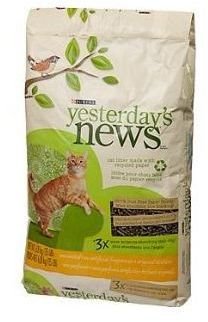Is Compostable Kitty Litter OK for the Environment?
Disadvantages of Traditional Clay & Silica Kitty Litter
Regular clay or silica based cat litters do not offer an eco-friendly solution to pet cat owners, and have the following disadvantages:
-
They contain hazardous dust particles, notably silica dust, that can harm your pets health. Studies have shown that cats suffering from respiratory conditions have six times more silica in their lungs than healthy cats.
-
As they are mined products, they are obtained in a manner which not only degrades the environment, but it is also not sustainable in the long-term.
-
They are not biodegradable, and contribute heavily to landfill sites all over the country.
However, the eco-conscious cat lover need not despair as compostable kitty litter, manufactured from natural products that are readily biodegradable are available on the market in various forms. These include wheat and corn kitty litter, wood pellet kitty litter, and paper based kitty litter. As they are made from natural products that quickly break down in the environment, they can be added to the compost heap or used in the garden as mulch, making disposing of kitty litter both convenient and environmentally friendly.
Recycled Paper Kitty Litter
Yesterday’s News, as the name implies, is a paper based kitty litter, manufactured from recycled products, including newspaper, corrugated cardboard and recycled industrial sawdust. Yesterday’s News not only utilizes recycled products in the manufacturing process, but as it is readily biodegradable, it can be further recycled and put to use in your garden through composting. This pelleted kitty litter offers 300 times better absorbency than other cat litters on the market, making it an economical option, as you will use far less to get the job done. It has no chemical additives, and contains no hazardous dust particles, making it a safe option for your pet, your family and the planet.
Wood Pellet Kitty Litter
Feline Pine Cat Litter is a natural, fully biodegradable wood pellet kitty litter manufactured from natural pine. It too is dust and chemical free, and can be flushed, added to the compost heap, or used as garden mulch, making it a product that can be recycled and used for the benefit of your garden. Feline Pine Original is a non-clumpable cat litter, but the pellets are non-tracking, and it is an economical option as the litter only needs replacing once the pellets dissolve, typically lasting for about two weeks. Feline Pine Scoop is a clumping version of Feline Pine original that contains guar bean gum, a natural clumping agent. Cedarific cat litter is an another natural wood based, fully biodegradable and compostable kitty litter on the market.
Wheat & Corn Kitty Litter
<img src="https://images.brighthub.com/03/3/033bd5d9801c79cbd16de30bbb80da25cf0ece0f_small.jpg" alt="Article Image" title="Article Image">Manufactured from processed corn kernels, the World’s Best Cat Litter offers a clumping kitty litter that is easy to scoop. This corn-based product is fully biodegradable, and can be flushed or composted. As it contains very little dust, and is chemical and fragrance free, it is a healthy option for your cat. It is even safe for kittens that sometimes ingest litter, which can cause serious health problems with other clumping kitty litter. The downside is that it is fairly pricey. The World’s Best kitty litter also comes in multi-cat and extra-strength versions.
Swheat Scoop is another natural clumping cat litter, made from wheat kernels, that can be composted or flushed down the toilet. It also comes in a multi-cat version, that has faster clumping action.
Disposing of Kitty Litter
While microorganisms in the soil will readily break down urine and feces into nitrites and nitrates that is then made available to plants for growth, pet waste often contains pathogens that are not readily decomposed, and may pose some health risks to both humans and wildlife.
Flushable kitty litter sounds like a convenient method to dispose of kitty litter, waste water treatment facilities do not recommend this as it could result in blocked pipes and damaged equipment. Furthermore, cat waste can contain pathogens such as Toxoplasma gondii, the protozoan that is responsible for toxoplasmosis, which can be transmitted across the placenta, and can cause birth defects or even kill an unborn child in a mother’s womb. For this reason pregnant women are cautioned against cleaning cat litter boxes. Recent studies have indicated that toxoplasmosis is responsible for the sudden decline in protected sea otter populations. Scientists believe that parasite eggs in cat droppings are responsible for contaminating water systems, which ultimately flow to the sea where it infects otters, resulting in high mortality rates.
Therefore, the safest and most ecologically sound way to dispose of cat droppings is to scoop the solid matter out of the litter, place it in a sealed plastic bag, and dispose of the bag in the garbage. Once the solid cat droppings are removed, the compostable kitty litter can then be safely added to the compost heap where it will quickly decompose into organic matter that can be recycled to the benefit of your garden or veggie patch.
Resources
References
Amazon.com, https://www.amazon.com
GreenYour.com, https://www.greenyour.com/lifestyle/pets/cat/tips/choose-biodegradable-kitty-litter
Eco-Cycle: Properly Disposing of Pet Waste, https://www.ecocycle.org/askeco-cycle/2005/0701.cfm
NOAA. Parasite in Cats Killing Sea Otters, https://www.magazine.noaa.gov/stories/mag72.htm
Image Credits
Amazon.com, https://www.amazon.com
